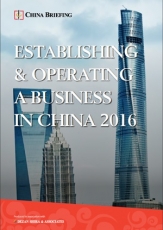China Market Watch: Industry Profit Increase and China-New Zealand Organic Food Agreement
China industrial profit growth sees rise in October
China’s National Bureau of Statistics has reported that profits of the country’s industrial sector had risen in the month of October to 9.8 percent, up from 7.7 percent in September, due to sales revenue growth, rising producer prices, and strong profit growth in the coal, chemical, and technical equipment sectors. October’s producer price index (PPI) also saw an increase of 1.2 percent year-on-year, up 0.1 percent on September’s figures, and are expected to remain positive in the coming months. China’s industry profits have made a strong recovery this year after declining last year, partially due to a rise in commodity prices as a consequence of tightened supply under the government’s capacity reduction scheme. However, this growth has been derived mainly from heavy polluting industries.
China’s winter sports industry to reach RMB 1 trillion by 2025
China’s National Development and Reform Commission (NDRC) has estimated that the country’s winter sports industry is expected to reach RMB 1 trillion by 2025, while announcing development plans for winter sports in China. It aims for 50 million people to directly participate in winter sports by 2025, boosted by Beijing hosting the 2022 Winter Olympics. There are also plans to construct a further 500 skating rinks, 650 skating gyms, and 800 ski resorts before the games. The government’s push for national interest in sports tourism, especially involving winter sports, is leading the way in the shift of lifestyle from consumption to more active recreational activities. Sports tourism is the fastest growing component of China’s huge travel industry, valued at RMB 206.5 billion last year.
![]() RELATED: Business Advisory Services from Dezan Shira & Associates
RELATED: Business Advisory Services from Dezan Shira & Associates
China’s grid-connected wind power capacity increases
China’s National Energy Administration (NEA) has released data that shows that wind power capacity connected to the state grid has increased, after years of decline following a long period of significant expansion. Facilities connected to the power grid had reached 139 million kilowatts by the end of this September, up 28 percent on the previous year. Its growth rate overtook that of national power use, totaling 4.5 percent year-on-year in the first nine months of 2016, with 10 million kilowatts of increased connected wind power capacity. Yunnan province recorded the largest gain in connected wind power facilities, adding 2.26 million kilowatts of capacity in the first nine months of the year. China has committed to increasing its green and renewable energy efforts.
China and New Zealand sign organic food production agreement, fostering increased trade
China has signed a mutual recognition arrangement for certified organic products with New Zealand, which will help to support the development of the organics industry in China and encourage a strong export chain with New Zealand by providing greater assurance for consumers. New Zealand’s Ministry for Primary Industries (MPI) has conducted an assessment of the Chinese organic food production system, and following its approval signed the agreement, providing confidence in the supply of organic foods deriving from China. New Zealand’s export of organic foods to China were worth RMB 130 million last year, and are expected to be boosted by the arrangement, which will take effect from 2017.
|
Asia Briefing Ltd. is a subsidiary of Dezan Shira & Associates. Dezan Shira is a specialist foreign direct investment practice, providing corporate establishment, business advisory, tax advisory and compliance, accounting, payroll, due diligence and financial review services to multinationals investing in China, Hong Kong, India, Vietnam, Singapore and the rest of ASEAN. For further information, please email china@dezshira.com or visit www.dezshira.com. Stay up to date with the latest business and investment trends in Asia by subscribing to our complimentary update service featuring news, commentary and regulatory insight.
|

 Establishing & Operating a Business in China 2016
Establishing & Operating a Business in China 2016
Establishing & Operating a Business in China 2016, produced in collaboration with the experts at Dezan Shira & Associates, explores the establishment procedures and related considerations of the Representative Office (RO), and two types of Limited Liability Companies: the Wholly Foreign-owned Enterprise (WFOE) and the Sino-foreign Joint Venture (JV). The guide also includes issues specific to Hong Kong and Singapore holding companies, and details how foreign investors can close a foreign-invested enterprise smoothly in China.
 An Introduction to Doing Business in China 2016
An Introduction to Doing Business in China 2016
Doing Business in China 2016 is designed to introduce the fundamentals of investing in China. Compiled by the professionals at Dezan Shira & Associates in June 2016, this comprehensive guide is ideal not only for businesses looking to enter the Chinese market, but also for companies who already have a presence here and want to keep up-to-date with the most recent and relevant policy changesSelling, Sourcing and E-commerce in China 2016
 China Investment Roadmap: the Food & Beverage Industry
China Investment Roadmap: the Food & Beverage Industry
In this edition of China Briefing, we examine two areas of Chinese food regulations most pertinent for foreign investors today – licensing and certification, and food safety standards. Both have undergone significant change in recent years, altering the way in which foreign companies must engage with the food & beverage industry, and must be thoroughly understood prior to market entry.
- Previous Article Case Study: Capital Gain Tax Treatment- Part 2: Capital Gain Tax Calculation
- Next Article Is the TPP Dead, or Will it Merge into the Free Trade Area of the Asia-Pacific?










